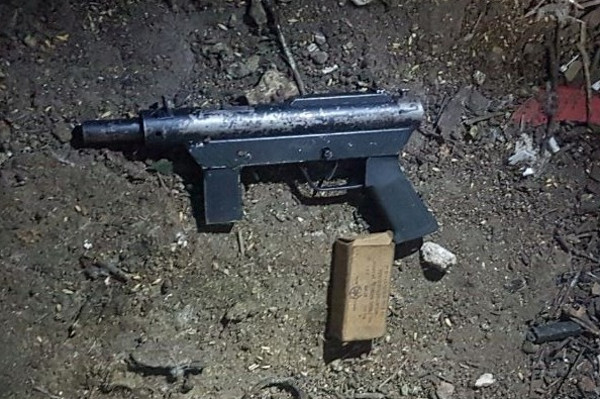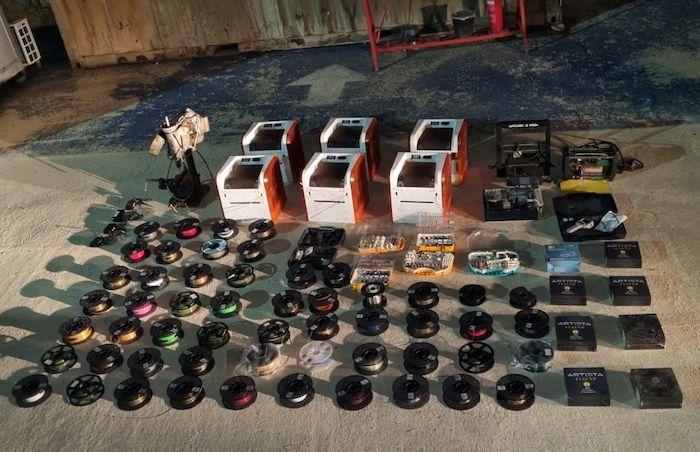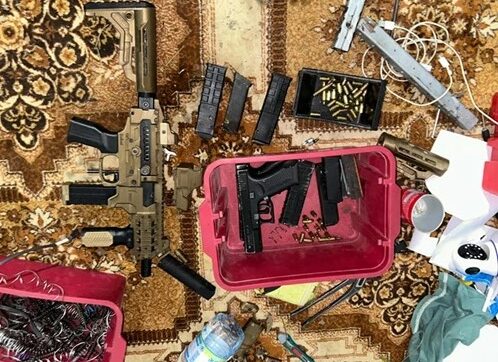Arrests related to 3D printed firearms are increasing alongside the emergence of additive manufacturing (AM) being deployed within areas of ongoing military conflict. This has been demonstrated significantly by rebel forces in Myanmar and, more recently, in the West Bank of Palestine, where the Israeli military confiscated desktop 3D printers along with guns made with the technology, according to the Israeli Defense Forces (IDF).
While performing routine counterinsurgency activities in the West Bank, an IDF Combat Engineering group uncovered a supply of weapons, including three pistols, a rifle, and other elements. Upon recovering eight 3D printers, 65 spools of filament, and “printing plans,” the crew determine the firearms to be 3D printed. The guns included internal mechanisms that allowed for the live firing of weapons. This represents the first time that the IDF has linked 3D printing to weapons manufacturing in the West Bank.
“These are entirely functional weapons. After closer examination, we saw they contained components that enabled them to cause harm. It was truly a digital lathe,” said the Commanding Officer of the 601st Combat Engineering Battalion. “This is a phenomenon that we have yet to encounter. We will increase the intelligence effort regarding this issue and continue to conduct extensive counterterrorism activities in the region. Our work begins with staying vigilant as we handle this issue to ensure it does not harm
The Israeli military suggests that it has increased its patrolling of the regions of Judea and Samaria due to a tradition of Palestinians celebrating their graduations from secondary school by firing guns into the air. This led to 36 arrests during 42 searches over the past five months.
The incident raises a number of issues echoed in the story of Malaysian rebels and 3D printed weaponry and more. Because the West Bank and Gaza are contested territories occupied by Israeli military forces, the situation can be viewed differently depending on one’s view of the conflict. The IDF, for instance, would certainly view the production of weapons by Palestinians as a threat, while others might align the activity with those of the Malaysian forces fighting their military coup.

A DIY Carlo-style submachine gun allegedly used in a shooting attack in the West Bank in 2017. Image courtesy of the Times of Israel.
Only the Palestinian security apparatus is allowed to own firearms in the West Bank, while Israelis who have served as junior members of the armed forces or above, as well as civilians who have completed security courses, can obtain permits to carry weapons. For this reason, illegal gun manufacturing and procurement is high in the territory, both serving criminal elements and those wishing to protect themselves against violence from settlers. As a result, the IDF has been cracking down on small machine shops that produced guns for sale on the black market.
Even more restricted is Gaza, where an ongoing blockade prevents the entry of a wide variety of goods, military and otherwise. There, 3D printing has been used to introduce elements of medical care—like stethoscopes, tourniquets, masks for burn victims, and more—when supplies cannot be obtained. Though illegal weapons utilized by rebel groups would threaten the IDF, one can imagine how increased state control over 3D printers could further reduce the access of Palestinians to medical supplies in the territory.
Taken together, these issues complicate the matter of 3D printed firearms, as non-state forces that rely on DIY weaponry may or may not be viewed as sympathetic depending on perspective and, more importantly, the same technology that produce guns cheaply can do the same for medical supplies and other goods.
All of this just barely scratches the surface of an even broader problem in the 3D printing industry that has less to do with weapons and more to do with 3D printer manufacturers. As stated when the war in Ukraine began, the AM industry may have to someday reckon with the political realities of where and how its products are made such that boycotting one country in the midst of a military conflict could lead to boycotts of others.
Regardless of how one approaches this story, however, it’s certain that military forces globally are learning a great deal of how 3D printing can be used in warfare by both state and non-state forces. Whether it’s bombs or bridges, tourniquets or drones, 3D printing is showcasing its true capabilities on the front line to military planners.
Subscribe to Our Email Newsletter
Stay up-to-date on all the latest news from the 3D printing industry and receive information and offers from third party vendors.
Print Services
Upload your 3D Models and get them printed quickly and efficiently.
You May Also Like
Reinventing Reindustrialization: Why NAVWAR Project Manager Spencer Koroly Invented a Made-in-America 3D Printer
It has become virtually impossible to regularly follow additive manufacturing (AM) industry news and not stumble across the term “defense industrial base” (DIB), a concept encompassing all the many diverse...
Inside The Barnes Global Advisors’ Vision for a Stronger AM Ecosystem
As additive manufacturing (AM) continues to revolutionize the industrial landscape, Pittsburgh-based consultancy The Barnes Global Advisors (TBGA) is helping shape what that future looks like. As the largest independent AM...
Ruggedized: How USMC Innovation Officer Matt Pine Navigates 3D Printing in the Military
Disclaimer: Matt Pine’s views are not the views of the Department of Defense nor the U.S. Marine Corps Throughout this decade thus far, the military’s adoption of additive manufacturing (AM)...
U.S. Congress Calls Out 3D Printing in Proposal for Commercial Reserve Manufacturing Network
Last week, the U.S. House of Representatives’ Appropriations Committee moved the FY 2026 defense bill forward to the House floor. Included in the legislation is a $131 million proposal for...



































